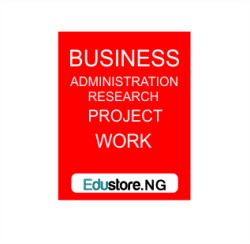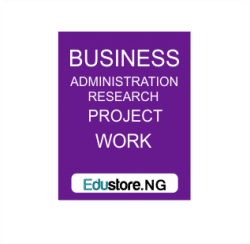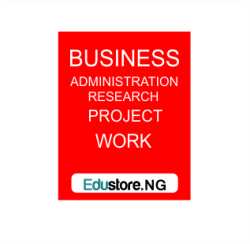THE IMPACT OF INFORMATION TECHNOLOGY ON BUSINESS ADMINISTRATION AND MANAGEMENT
(A CASE STUDY OF NITEL, ENUGU)
ABSTRACT
The main purpose of this research work is to determine the impact of information Technology on NITEL, Enugu. In order to achieve this purpose or objective very successfully the researcher has taken into consideration: the meaning or concept of information Technology, the negative and positive effects of information Technology, the characteristics or attitudes of Information Technology, the personnel / staff, etc.
Having observe the above, the researcher equally delved into the problems associated with information Technology. Consequently, the conclusions reached was that certain factors such as staff redundancy, fraud, high maintenance or repair cost are some of the problems associated with Information Technology at NITEL.
The researcher made some useful recommendations that would aid the effective management and applied Information Technology.
TABLE OF CONTENTS CHAPTER ONE
1.0 Introduction
1.1 Background Of The Study
1.2 Statement Of The Problem
1.3 Purpose Of The Study
1.4 Scope Of The Study
1.5 Research Questions
1.6 Research Hypothesis
1.7 Significance Of The Study
1.8 Definition Of Terms
References
CHAPTER TWO
2.0 Review Of Related Literature
2.1 The Concept Of It And Business Administration On Business Administration And Management
2.2 Positive Effects Of Information Technology On Business Management.
2.3 Negative Effects Of Information Technology At Nitel
2.4 Various Products Information Technology Used In Business Administration And Management.
2.5 Consideration Made By NITEL In Choosing Information Technology Equipment
2.6 Personal Characteristics/Attributes That Are Appropriate For Information Services Personnel at NITEL
2.7 Reference Materials And Correction Symbols
References
CHAPTER THREE
3.0 Research Design And Methodology
3.1 Research Design
3.2 Areas Of The Study
3.3 Population Of The Study
3.4 Sample And Sampling Procedure Technique
3.5 Instrument For Data Collection
3.6 Validation Of The Instrument
3.7 Reliability Of The Instrument
3.8 Method Of Data Collection
3.9 Method Of Data Analysis
References
CHAPTER FOUR
4.0 Data Presentation And Analysis
4.1 Presentation And Analysis Of Data
4.2 Testing Of Hypothesis
4.3 Summary Of Results
References
CHAPTER FIVE
5.0 Discussion Of Recommendation And Conclusions
5.1 Discussion Of Result / Findings
5.2 Conclusions –
5.3 Implications Of The Findings
5.4 Recommendations
5.5 Suggestion For Further Research
BIBLIOGRAPHY
APPENDIX A
APPENDIX B
CHAPTER ONE INTRODUCTION
1.1 BACKGROUND OF THE STUDY
I
nformation is not only the basic of human existence. It is also the life wire for running of any organization. This is consequent upon the fact that decisions are based on information for effective decision-making and effective execution of those decisions, there must be constant information flow. Data gathered must be transmitted to the end –users after it had been processed. Information receipt processing, storage, dissemination, etc. may be instant; otherwise valuable business opportunities might be lost. That is what Information Technology (IT) seeks to do in business administration and management.
The development of information technology has come a long way. The first writing in the world of was invented by Egyptians priests around four thousand B.C. At first, the writing was a series of whole picture, which were drawn to tell a story. This took a long time and later on the priests learned to draw parts of pictures to represent the whole. Much later on still, the pictures were drawn not to represent objects, but to represent sounds. Thus the picture of a house was drawn not to represent the actual building, but the sound “Haus”. Gradually, the method of writing was improved upon until one letter was used to represent one sound. This is how the first alphabet was made. The priests wrote with a reed pen and made ink by mixing soot and gum with water.
But the scope of the writing called the HIEROGLYPHICS was restricted to priests; hence it was called SACRED writing. The writing was used to record important religious ceremonies, medical facts and records of kings and nobles. The most important writings were recorded or carved on stones while the less important records were kept on thin stripes from a reed known as PAPYRUS, a plant that grew on the banks of the River Nile. The modern word “paper” came from papyrus.
Other ancient ways of writing include the SUMMERIAN CUNELFORM, ANTHENIAN OSTRAKON, JEWISH SCROLL or parchment, which was writing on animal skin. The Bible recorded in Exodus 3`: 18, “And the lord gave Moses, when he, (God) had made as an end of speaking with him upon the mount Sinai, the two tables of stone written with the finger of God”. An Assyrian king named Assurbanipal was said to have about twenty thousand clay tablets in his private library.
For their information dissemination, the ancient world employed a number of ways. The Greek used runners. The marathon race today is in honor of an Athenian runner who not only ran all the way from Athens to Sparta to call the Spartans to the battle field, but also after the Persians had been defeated at a place called marathon, ran a further 35 kilometers to Athens to report the victory, after which he fell down dead after announcing the victory.
The old-talking drums, gongs, etc. were also used to send out information. In emergency situations, a section of the forest could be set on fire to warn people of impending or sudden enemy attack. All those various means of receiving, storing and sending information in the ancient times have been replaced by the vast array of machines in the modern world. This is what is called information technology, which refers to a host of equipment and materials, essentially computer-based that are used in the modern world for information receipt, processing, storage and dissemination.
The invention of the printing machine by a German called John Guttenberg; the calculating machine invented by Charles Babbage in 1855; the typewriter invented in 1867 by the Sholes brothers of America; the invention of the telephone in 1876 by a Scot Alexandra Graham Bell; the invention of radio in 1895 by Marches Marcini; the television in 1922 by Johnlogis Baird; the turnaround brought about with the invention of the photographing machine in 1826 by Joseph Niece, a French and so on have marked a turning point in Information Technology. From the earliest times to the modern times, precisely the twenty-first century, information technology has spanned three distinct stages. These are: –
i. Primary stage – use of human labor
ii. Secondary stage – use of electrical machines
iii. Tertiary stage – use of electronics machines.
The modern age is aptly called the age of machines or the machine age. This is true in the light of the numberless communication gadgets and information equipment that have flooded the market. But the greatest of this revolution is the computer, which has now revolutionized the modern business world.
The primary stage was the period during which human labor was used enormously in information receipt, storage and dissemination. At that time, electricity was not popular as it came into human existence in 1831 by Michael Faraday. The manual typewriter came under this stage.
The secondary stage was the period during which electricity became the source of power for some machines. The electric typewriters came under this stage and also many other machines that became electrically powered.
The last stage is the tertiary stage, which is the present age of electronics, is the power source of communication equipment.
1.2 STATEMENT OF PROBLEMS.
Information technology has given birth to many complex machines, some of which are beyond the operational scope of an average businessman.
According to Hirsch, the machine age brought about the development of methods. Business executive, administrators, managers and staff need to go beyond their natural endowment to be able to understand the operations and procedures of these machines and also be able to operate these machines themselves. This makes training a sine-qua-non. But only very few business and individuals can afford the high cost of training required to operate those machines. This cost becomes an impossibility when it involves an overseas training course.
Moreover, the costs of acquiring the machines are very exorbitant. The exchange rate of the naira is too down to earth when compared with other major currencies of the world, like the American dollars, British pounds, Japanese yen, German Dutch mark, French francs etc. The cheapest manual portable typewriter costs about Nine thousand naira which is out of financial capability of some business organizations, how much more the computer, photocopiers, fax machines, etc. whose costs run into nearly hundreds of thousands of naira to purchase. The high cost of machine is almost defeating the goal of information technology.
Another problem associated with information technology is servicing and maintenance of the machines. All these machines are manufactured in highly technologically advanced countries such as Germany, France, America, Japan, Britain, etc. When they are imported into Nigeria and other third world countries, the user nations lack the expertise and technical know-how to maintain and service the machines. This is because the qualified service personnel required to service machines are not brought along with the machines. The implications of this are that half-baked technicians are forced to service the machines. Rather than putting the equipment back into use, they spoil it. This results in scrapping many of the machines. When these machines breakdown, the business can no longer use them and the operations of that business are greatly impaired.
Finally, the world of information technology is an ever-changing sea. The rate at which the manufacturers and producers turn out these machines overwhelms stakeholders in the business world. It is very difficult to keep pace with the influx of these communication gadgets. As new discoveries are made, new machines are manufactured with their attendant different operational procedures. This keeps stakeholders on their toes as they are unsure about what is to replace the present machines.
1.3 PURPOSE OF STUDY.
The main purpose of this study is to find out the impact of information technology on Business Administration and management.
In addition, this study will also try to: –
a) Establish the true meaning of business in the modern world;
b) Find out what level of training is required for proper handling of products of information technology;
c) Determine the different environments under which businesses are operated in the modern world of information technology;
d) Find out the personal characteristics or the essential qualities appropriate for information technology personnel;
e) Find out the various information technology machines used in business administration and management;
f) Identify some of correction symbols used in information technology;
g) Make recommendations on ways and means of making information technology more efficient and effective.
1.4 SCOPE OF THE STUDY.
This study is limited to the effects made by information technology on business administration. This covers both the positive and negative impact of information technology.
The Nigerian Telecommunications PLC branch at Okpara Avenue Enugu was used as case study. Operators of the various machines used in information services, who are the major stakeholders in the information industry were also interviewed.
1.5 RESEARCH QUESTIONS.
(a) Has information technology made any impact on NITEL in Nigeria?
(b) What are the various information technology equipment used by NITEL in Nigeria?
(c) In what way has information technology negatively affected on NITEL in Nigeria?
(d) What are the personal characteristics and attributes required of NITEL staff in the age of information technology?
(e) What are the correction symbols, reference materials and standard abbreviations used by NITEL staff in information technology?
1.6 RESEARCH HYPOTHESIS (ALTERNATIVE)
The following hypothesis have been advanced for the purpose of this study:
a) Information technology has a direct impact on business administration and management;
b) The various machines of information technology used in business administration and management require effective handling;
c) Information technology has revolutionized the business world;
d) Information technology has resulted in staff redundancy in business today;
e) Various machines and equipment are used in information services;
f) A business cannot be successfully run today without the information technology,
1.7 SIGNIFICANCE OF THE STUDY.
There is no gain saying the fact that this study will benefit a number of people in a number of ways.
It is hoped that through this study, the stakeholders in the information industry would be enlightened in terms of knowledge, qualification, experience and performance appraisal.
Moreover, it will highlight the need for higher institutions of learning and other agencies engaged in the training of computer or information services to combine theory with practical. This can only be made possible if those schools are agencies procure the machines themselves.
The larger society will benefit from this study in that it will educate them on the many sides to information technology and its effectiveness in business administration and management in the modern business world.
In addition, this study will be of significance to the government with respect to policies on the importation of information equipment. The high costs of these machines are consequent upon the high tariff imposed on the machines. If the import tax is relaxed or lowered, the cost of the machines become less and therefore affordable.
Finally, this study no doubt will contribute to learning and then add to the frontiers of knowledge.
1.8 DEFINITION OF TERMS.
Owing to the multiplicity of meanings of words in certain cases, the researcher needed to give certain words used in this study their contextual meanings.
a) Information technology.
This refers to a host of machines that are used in today’s business world for information receipt, processing, storage and disemination,etc.
b) Data.
This is unprocessed information. It is information that is in its raw or unorganized state.
c) Information.
This is the result of processed data. It is a combination of data plus processing. It is data in its organized and processed state, which can be used in making business decisions.
d) File.
This is a group of related data or information.
e) Hardware.
This includes the physical components of information handling.
f) Software.
Programs for the computer.
g) Processing.
A series of events, actions or operations that transfer the original material, that is data into finished product called information.
DOWNLOAD COMPLETE WORK- For Reference Only: Materials are for research, citation, and idea generation purposes and not for submission as your original final year project work.
- Avoid Plagiarism: Do not copy or submit this content as your own project. Doing so may result in academic consequences.
- Use as a Framework: This complete project research material should guide the development of your own final year project work.
- Academic Access: This platform is designed to reduce the stress of visiting school libraries by providing easy access to research materials.
- Institutional Support: Tertiary institutions encourage the review of previous academic works such as journals and theses.
- Open Education: The site is maintained through paid subscriptions to continue offering open access educational resources.






